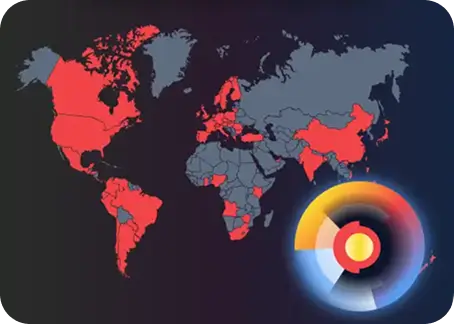Proof of Address Verification in 2025: Complete Guide to Compliance, Risk & Shufti Insights

- 01 1. 2025 Snapshot: Why Proof of Address Matters More Than Ever
- 02 2. What Is Proof of Address (PoA)?
- 03 3. Accepted & Rejected PoA Documents in 2025
- 04 4. Global Regulations Shaping PoA in 2025
- 05 5. How Proof of Address Verification Works in 2025
- 06 6. Shufti 2025 Analytics: Fraud Trends & Product Upgrades
- 07 7. Geolocation & Digital Wallets: Emerging Alternatives
- 08 8. Submitting PoA: Best Practices for 2025
- 09 9. Top 10 PoA Document Pitfalls
- 10 10. How Shufti Ensures Accurate PoA
- 11 References
1. 2025 Snapshot: Why Proof of Address Matters More Than Ever
In 2025, proof of address (PoA) has become a linchpin of every Know Your Customer (KYC) programme. Global fraud losses touched £1.17 billion in the UK alone last year with address manipulation featuring in one‑in‑five cases. Meanwhile, the address‑verification software market is projected to hit US $2.62 billion by 2029, fuelled by tighter anti‑money‑laundering (AML) rules and booming cross‑border e‑commerce. Organisations that can’t validate where a customer genuinely lives risk regulatory fines, lost shipments, and reputational damage.
2. What Is Proof of Address (PoA)?
PoA is documentary or digital evidence that ties an individual to a physical or legally recognised address. When combined with identity documents, PoA helps meet AML/CTF requirements and reduces fraud by confirming residency, jurisdiction, and eligibility for region‑specific products.
Typical Data Points Verified
- Full residential address (street, city, postcode, country)
- Name match between PoA and ID document
- Date of issue/statement period (freshness)
- Official issuer (e.g., utility provider, bank, government agency)
3. Accepted & Rejected PoA Documents in 2025
Before diving into specific documents, it’s important to understand why certain proofs carry more evidential weight in 2025. Regulators and postal authorities have tightened age thresholds and authenticity requirements, so enterprises must curate a clear whitelist and blacklist to maintain defensible compliance.
Accepted (issue ≤ 3 months unless stated)
- Mortgage or rent statement (paper or certified e‑PDF)
- Original utility bill (gas, water, electricity)
- Bank/building‑society account‑opening letter
- Pension or benefits statement (UK & Channel Islands)
- Council‑tax bill (paper copy)
- Digital identity wallet credential with eIDAS 2.0 Assurance Level High stamp
Rejected
- Hand‑written documents or receipts
- Out‑of‑date statements (> 3 months, except pensions ≤ 12 months)
- Blurred, cropped, or AI‑generated documents
- Documents lacking issue date or issuing authority
Source: UK GOV acceptable‑PoA list, updated 19 June 2025.
4. Global Regulations Shaping PoA in 2025
From Brussels to Washington, 2025 has ushered in landmark AML directives that converge on one principle: robust, refreshable address evidence. Below is a concise roundup of the rules most likely to affect global onboarding pipelines.
4.1 EU: AML ‘Single Rulebook’ Regulation (EU 2024/1624) & AMLA
The EU’s Single Rulebook, effective 10 July 2027 with preparatory measures rolling out now, harmonises CDD expectations across member states and introduces the Anti‑Money‑Laundering Authority (AMLA) from 1 July 2025. Firms must collect reliable PoA records and refresh them at least every five years (one year for high‑risk customers).
4.2 UK: FCA Handbook Notice 127 (February 2025)
The FCA lowered the threshold for occasional‑transaction due diligence from £15,000 to £10,000 and reinforced document‑freshness guidance: PoA more than three months old now triggers enhanced due diligence (EDD).
4.3 US: FinCEN Beneficial Ownership (BOI) Rule
Enforced from January 2025, BOI reporting obliges thousands of SMEs to file beneficial‑owner PoA documents alongside IDs, extending traditional CDD procedures to non‑financial entities.
5. How Proof of Address Verification Works in 2025
Modern address verification is no longer a manual box‑ticking exercise; it’s an AI‑assisted pipeline that couples document science with data orchestration. Here’s how the workflow unfolds inside Shufti’s platform in 2025.
- Document Collection – customers upload a PoA document or share a wallet credential.
- AI‑OCR Extraction – Shufti’s in‑house OCR captures text with 98.67 % accuracy.
- Address Decomposition & Normalisation – launched 5 March 2025, the engine splits addresses into house number, street, city, region, and postal code for precision matching.
- Cross‑Checks – data is validated against global postal databases and verified with ID information.
- Fraud Screening – deep‑learning models flag forged, manipulated, or synthetic documents in < 800 ms.
- Decision & Audit Trail – pass/fail plus risk‑score and cryptographic proof stored for seven years.
6. Shufti 2025 Analytics: Fraud Trends & Product Upgrades
Internal telemetry across more than 230 million global checks gives Shufti a unique lens on evolving attack vectors. The following headline numbers highlight where fraudsters are focusing—and how our product roadmap is responding.
- PoA fraud attempts rose 18 % YoY in H1 2025, with synthetic addresses accounting for 42 % of all high‑risk cases.
- Deep‑fake or AI‑generated IDs now trigger 31 % of Shufti high‑risk alerts (Q1 2025).
- eIDV Pro coverage expanded from 61 → 63 countries (March 2025), giving broader database cross‑checks.
- Edge‑deployment option slashes latency to < 600 ms, ideal for on‑prem compliance needs.
7. Geolocation & Digital Wallets: Emerging Alternatives
FATF’s Digital‑ID Guidance encourages tiered CDD using secure geolocation signals for low‑risk cases. At the same time, eIDAS 2.0 digital wallets let users share verifiable address attributes instantly, while the EU AI Act designates document‑verification AI as a high‑risk system, mandating human‑oversight and detailed audit logs.
8. Submitting PoA: Best Practices for 2025
Even the best technology falters without clean inputs. Encourage customers to follow these submission tips to maximise first‑time pass rates and minimise costly back‑and‑forth.
- Upload colour scans/PDFs at ≥ 300 DPI.
- Ensure full address and issue date are visible.
- Provide the latest version of recurring bills.
- Avoid screenshots; use original downloads or photos.
- Give explicit consent for geolocation if requested.
9. Top 10 PoA Document Pitfalls
The majority of PoA failures stem from avoidable oversights. Steering clear of the pitfalls below can lift approval rates by up to 11 %, according to Shufti’s 2025 data.
- Blurred or low‑resolution images.
- Cropped edges hiding address lines.
- Mixed temporary & permanent addresses.
- Expired or undated statements.
- AI‑generated or tampered PDFs.
- Multiple versions causing mismatches.
- Missing issuer signature or logo.
- Language barriers without transliteration.
- Non‑standard abbreviations (e.g., “St.” vs “Street”).
- Privacy‑blurred sensitive lines (data redaction too aggressive).
10. How Shufti Ensures Accurate PoA
Shufti’s Global Trust Platform combines address decomposition, fuzzy‑match algorithms, and jurisdiction‑aware rule‑sets. The Journey Builder lets compliance teams customise match thresholds, while real‑time dashboards visualise anomaly patterns for proactive fraud defence.
References
- European Parliament & Council. Regulation (EU) 2024/1624 on the prevention of the use of the financial system for the purposes of money laundering or terrorist financing (“Single Rulebook”).
- European Banking Authority. (2025). Revised Guidelines on Customer Due Diligence.
- UK Financial Conduct Authority. Handbook Notice 127 (February 2025).
- FinCEN. (2024). Beneficial Ownership Information Reporting Rule — Small Entity Guide.
- FATF. (2024). Guidance on Digital Identity.
Shufti Internal Analytics Dashboard, Q1–Q2 2025.
Frequently Asked Questions
What counts as proof of address in 2025?
Utility bills, bank statements, council-tax bills, mortgage statements, and qualified digital-wallet credentials issued within the last three months.
Is a digital bank statement acceptable?
Yes, if it's a PDF downloaded directly from the issuer, contains the full address, and is no older than 90 days.
Can geolocation replace a document?
Partially. Geolocation can complement PoA but rarely satisfies high-assurance regulations on its own.
How often must PoA be refreshed?
EU rules: every five years (one year for high-risk clients). UK FCA recommends three-year refresh for standard risk.
Does my verification provider store PoA images?
Most regulated verification providers encrypt PoA images and retain them for up to seven years or according to client policy to support audits and regulatory reviews.
What's new in PoA technology for 2025?
Advanced providers now offer address decomposition, expanded eIDV database coverage, and on-prem edge modules that deliver sub-second processing while meeting data-residency requirements.










